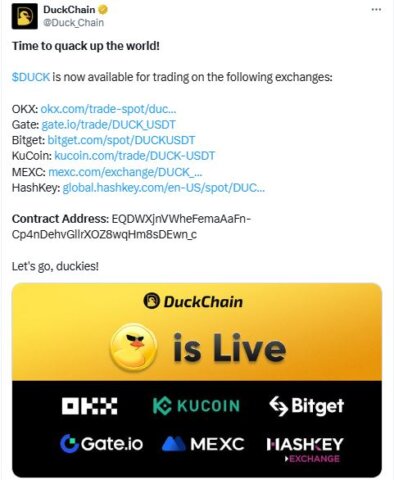Key Highlights
- DUCK maintains a maximum supply of 10 billion tokens, with about 5.4 billion currently circulating.
- The current DUCK price stands around $0.00227, with a 24-hour trading volume near $3.27 million.
- 77% of tokens go toward community rewards, gaming incentives, and ecosystem development.
- Core utilities include in-game purchases, NFTs, staking rewards, and governance voting.
- DuckChain operates as a Telegram gaming hub, merging Web3 with social chat.
What is DuckChain? The Telegram Gaming Hub
DuckChain functions as a Telegram-based consumer layer, blending gaming with blockchain features. Because it integrates directly with Telegram, users can participate in Web3 without leaving their chat environment.
This seamless experience creates opportunities for mass adoption. In addition, DuckChain builds on TON while remaining EVM compatible, which ensures cross-chain flexibility. As a result, DUCK positions itself as the central currency of this hybrid platform.
Moreover, DUCK connects all activities inside the ecosystem. Gamers spend it, collectors trade with it, and holders stake or vote with it. Consequently, the token becomes an indispensable part of the entire experience.
Live DUCK Price and Market Data
To fully understand DUCK tokenomics explained, real-time data offers essential context. Therefore, below is the latest snapshot from CoinGecko and TradingView.
| Metric | Value | Source |
|---|---|---|
| Current DUCK Price | $0.00227 USD | CoinGecko |
| 24-Hour Price Change | –2.21% | CoinGecko |
| 24-Hour Volume | $3.27 million | CoinGecko |
| Circulating Supply | ≈ 5.4 billion DUCK | CoinGecko |
| Max Supply | 10 billion DUCK | TradingView |
DUCK Token Supply Breakdown
Total Supply and Circulating Supply
The DUCK token features a maximum supply of 10 billion. At its token generation event, nearly 59% entered circulation, representing about 5.9 billion DUCK. Currently, the active circulating supply stands around 5.4 billion, while the rest unlocks gradually through vesting schedules.
As a result, investors track both the circulating supply and the fully diluted valuation (FDV). While FDV assumes the full 10 billion supply, circulating numbers give a clearer short-term view. Moreover, vesting prevents sudden oversupply, ensuring gradual market absorption.
Token Emission and Inflation Schedule
DuckChain implements a structured emission schedule. Because team, advisor, and investor allocations unlock slowly, the system avoids inflation spikes. Consequently, this design stabilizes price discovery and rewards long-term engagement.
Furthermore, the community benefits most, as 77% of the supply supports growth initiatives. These include gaming incentives, ecosystem rewards, liquidity support, and airdrops. Therefore, most DUCK flows back into user-driven activities.
Over time, inflation pressures decrease as token unlocks slow. This measured release ensures sustainability and aligns long-term holders with ecosystem success.

Primary DUCK Token Use Cases and Utility
To clarify DuckChain token use case and answer what is DUCK token used for, we must explore its utilities.
In-Game Purchases and NFTs
DUCK fuels in-game economies across Telegram-based games. Players use it for weapons, avatars, collectibles, and NFT transactions. Because NFTs integrate directly into Telegram, users buy, trade, and showcase them without friction.
Therefore, DUCK functions as a native payment layer, making it indispensable to the gaming experience. Moreover, collectible NFTs create lasting demand, extending DUCK’s reach beyond gaming into social and cultural spaces.
Staking and Earning Rewards
Holders may stake DUCK tokens to earn ongoing rewards. This staking model decreases circulating supply while motivating users to hold long term. Consequently, it aligns community incentives with overall ecosystem health.
In addition, staking stabilizes liquidity pools and secures the network. Since rewards accumulate over time, holders benefit from compounding returns. Therefore, staking transforms DUCK from a transactional asset into a yield-bearing instrument.
Network Governance and Voting
Governance forms another pillar of DUCK’s utility. Holders use tokens to propose and vote on upgrades, funding allocations, or new features. Consequently, the community drives key decisions.
Moreover, governance empowers users to shape DuckChain’s future, keeping it decentralized and transparent. This active participation transforms DUCK into more than just a token — it becomes a voice in the system’s growth.
Final Thoughts
In summary, DUCK tokenomics explained reveals a comprehensive model with capped supply, controlled emissions, and strong community-focused incentives. Real-time data shows DUCK trading near $0.0047, backed by significant liquidity and a circulating supply above 5 billion tokens.
Its main functions — in-game payments, NFT transactions, staking, and governance — illustrate exactly what DUCK token is used for. Therefore, its value lies not only in speculation but also in genuine utility within Telegram’s gaming ecosystem.
Moreover, with DuckChain token use case deeply tied to social chat platforms, DUCK represents an innovative step toward Web3 mass adoption. Consequently, if usage scales, the token could evolve into a core asset of gaming and governance inside Telegram.
Read Also: Ripple CTO Reveals XRPL Growth & Bold XBONK Strategies
Disclaimer!! The information provided by CryptopianNews is for educational and informational purposes only. It should not be considered financial or investment advice. Cryptocurrency markets are highly volatile and speculative, and investing in them carries inherent risks. Readers are advised to conduct their own research and consult with a qualified financial advisor before making any investment decisions.
- DUCK Tokenomics Explained: A Deep Dive into Supply, Utility, and Use Cases - September 28, 2025
- Ripple CTO Reveals XRPL Growth & Bold XBONK Strategies - September 26, 2025
- Franklin Templeton Expands Benji Tech to BNB Chain - September 25, 2025

